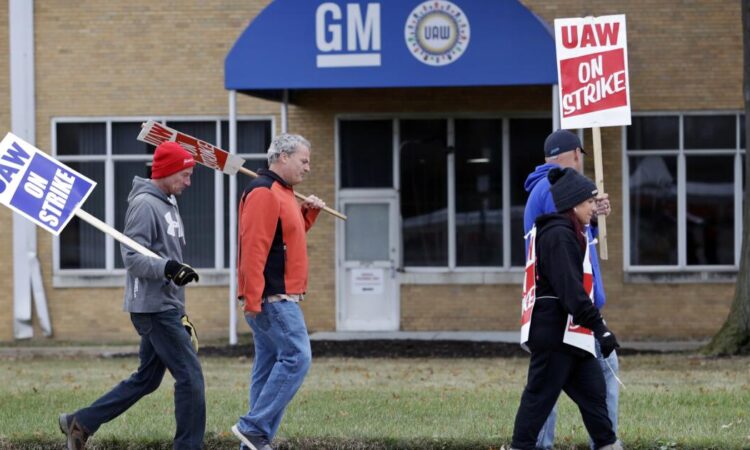
General Motors reached a tentative agreement with the United Auto Workers union, according to people familiar with the matter, bringing an end to a 6-week-old strike that had upended U.S. automobile production and cost the industry billions of dollars.
The terms of the pact are broadly similar to the deals signed earlier by Ford Motor Co. and Stellantis NV, including a 25% hourly pay raise plus cost-of-living allowances over the more-than-four-year contract, according to the people, who weren’t authorized to speak publicly. While the economic terms are similar to those reached by GM’s rivals, it wasn’t immediately clear if there are differences in retiree benefits, which has been a sticking point, according to the people.
GM’s 46,000 union members still must approve the deal.
The company’s shares jumped 3.9% on the news before paring gains in pre-market trading. They were up less than 1% as of 10:55 a.m. Eastern time in regular trading.
GM is the last of Detroit’s legacy automakers to reach an agreement with the union, which began its strike on Sept. 15. Ford’s deal last week put pressure on GM and Stellantis to wrap up their negotiations and get back to work. Stellantis was able to finalize its talks with the UAW on Saturday after agreeing to concessions on job security.
The agreements are a big step toward ending a bruising clash marked by tense bargaining and at times nasty rhetoric, particularly from UAW President Shawn Fain. The new union leader made this year’s labor talks a statement on income disparity, renewing a fight between labor and management. Assuming the deals are finalized, the union and companies will have to put any hard feelings behind them and find a way to work together.
Asked Monday about the tentative deals struck between automakers and the union, President Biden said it’s “great” the sides reached an agreement.
This was the first time all three of the Detroit automakers were struck at the same time, a bet by Fain to keep them guessing by incrementally adding more plants to the work stoppage. His strategy seems to have paid off with record wage hikes and the restoration of some benefits that the union forfeited during the financial crisis more than a decade ago.
The gains come amid a resurgence of labor activism in the United States. Emboldened by tight labor markets and agitated by inflation and risks shouldered during the COVID-19 pandemic, unionized workers have notched a series of victories in the last year at prominent U.S. companies, including Kaiser Permanente and United Parcel Service.
The UAW expanded its walkout at GM on Saturday by calling for another strike at the automaker’s Spring Hill, Tenn., plants. The UAW had previously targeted eight assembly plants and 38 parts-distribution facilities from the three automakers since the strike began Sept. 15, including at GM’s Arlington, Texas, facility that makes SUVs and a pickup truck plant in Missouri. The strikes at Ford and Stellantis ended when those companies reached tentative deals with the union.
Fain already has an eye on the next potential strike of the Detroit companies, moving the expiration of the new contract to the end of April 2028. If the workers walk out then, it would come on May 1, or May Day, which is historically an international day of labor.
The latest strike has taken a financial toll on the automakers, with both GM and Ford pulling their earnings guidance last week due to uncertainty surrounding the union talks. Ford said Thursday that the work stoppage cost the company $1.3 billion. GM said its strike costs had reached $800 million and would cost at least $200 million a week going forward.
GM had some unique issues compared to Ford. The automaker has 300,000 retirees, more than either rival, making improved pension payouts costly. GM also uses temps to make up 6% to 10% of its workforce, whereas Ford has used about 3%, making the impact of changes around temps different for each company.






